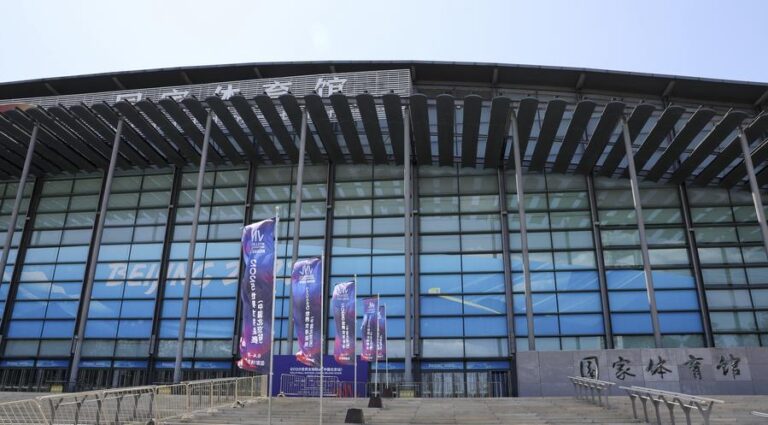Having previously hosted Olympic and Winter Olympic competitions, the National Indoor Stadium staged the FIVB Volleyball Nations League (VNL) Beijing leg over the past week, emphasizing its sustainable legacy.
by sportswriters Xiao Yazhuo, Wang Jingyu and Li Chunyu
BEIJING, June 9 (Xinhua) — From the fierce clashes of Olympic ice hockey to the roar of basketball fans and the graceful arcs of figure skating, Beijing’s National Indoor Stadium has become a model for sustainable Olympic venue use.
17 years after hosting gymnastics, trampoline and wheelchair basketball events at the 2008 Summer Olympics and Paralympics, and three years after staging ice hockey competitions during the 2022 Winter Olympics, the venue is once again welcoming world-class athletes, with the FIVB Volleyball Nations League (VNL) held at one of the city’s iconic “dual Olympic” venues.
At the heart of the stadium’s success lies a simple yet powerful strategy: putting sports first and sharing it with the community. In doing so, it reflects a broader vision of how Olympic legacy can serve both elite performance and public engagement.
“We’ve always believed that a world-class sports venue must serve athletes, spectators and the city alike,” National Indoor Stadium chairman Wang Yue told Xinhua.
SMART OPERATIONS, OLYMPIC LEGACY
Built for the 2008 Beijing Olympics, the National Indoor Stadium underwent major upgrades for the 2022 Winter Games, becoming one of the two ice hockey competition venues.
During renovations, designers incorporated a dual-size ice rink system, allowing conversion between the standard 60m x 26m Olympic ice hockey field and a 60m x 30m configuration for figure skating and other events. This design foresight laid the foundation for versatile, long-term use.
Following the Winter Olympics, the stadium returned to its sports-first mission under the Beijing Performing Arts Group, aligning with the city’s call to refocus Olympic venues on athletic development. Since then, it has hosted a growing portfolio of top-tier events and become home to Chinese Basketball Association (CBA) team the Beijing Royal Fighters.
“Our post-Olympic mission has been to fully return to our core mission – sports. This venue is designed to host elite competitions, and also to welcome citizens in their everyday lives. We’re building a world-class stadium brand rooted in Olympic spirit and open access,” Wang explained.
The venue’s reputation for professionalism has also been affirmed by visiting teams during the VNL.
“This stadium has amazing lighting and atmosphere. It makes the players feel like they’re on one of the world’s biggest stages,” said Turkey head coach Daniele Santarelli.
China captain Gong Xiangyu echoed this sentiment: “It’s exciting to play here. You feel the energy of the crowd and the history of the place.”
FROM OLYMPIC SPOTLIGHT TO DAILY USE
Since its post-Winter Olympics reopening, the stadium has focused on optimizing space and schedule through precise planning. With an annual calendar packed with over 60 major events – spanning volleyball, basketball, ice hockey, concerts and exhibitions – the venue runs on what its operators call a “full-time, full-space” model.
“We host around 30 professional sports events a year, and the same number of other commercial and cultural events,” said Wang.
Behind these seamless transitions is a core operation team of fewer than 20 people, who oversee everything from scheduling to logistical coordination.
“Our team is small but specialized,” Wang explained. “After a concert teardown at night, we can switch the space into basketball mode by the next morning.”

Beyond major events, the stadium shifts gears on non-match days to serve everyday fitness and public engagement.
“We offer rhythmic gymnastics and badminton classes in the main hall. The training hall becomes a hub for table tennis and balance-bike lessons,” Wang noted.
A dedicated ice hockey rink built for the Winter Games now supports both Beijing’s men’s ice hockey team and public skating hours, while outdoor tennis and 3×3 basketball courts are fully booked on weekends.
“Hosting events isn’t our only goal,” said Wang. “We want local residents to see this as their home stadium. Whether you’re watching volleyball or playing badminton with your children, this is the place for you.”
“We are positioning ourselves as an Olympic legacy venue that delivers on both elite performance and daily vitality,” he added.
BUILDING A SUSTAINABLE, PEOPLE-CENTERED MODEL
With the goal of long-term sustainability, the stadium is developing a diversified revenue model that combines core sports events with concerts, exhibitions, themed retail and dining.
“Our operations are now basically breaking even,” Wang noted. “We are pushing for a balance between economic return and public benefit.”
To support this strategy, the stadium is building two flagship sports brands: basketball and ice hockey.
“The Beijing Royal Fighters play most of their home games here. We’re also the training base and competition site for Beijing’s city-level ice hockey team,” said Wang, adding that these projects help drive identity and fan engagement.
Wang also emphasized the stadium’s public-service function.
“More than 1,000 amateur events are held here every year,” he said. “This isn’t a major profit center, but it’s about public value. As a state-owned venue, we must serve the community.”
The five-day VNL competitions have drawn tens of thousands of fans and ignited a new wave of enthusiasm. Visitors can use match tickets for discounts at restaurants and shops nearby – part of a growing “ticket stub economy” that ties sport with city life.
“Sport is more than a competition,” said Wang. “It’s a way to connect people, boost local business and enhance urban life. That’s the Olympic legacy we hope to continue.” ■

